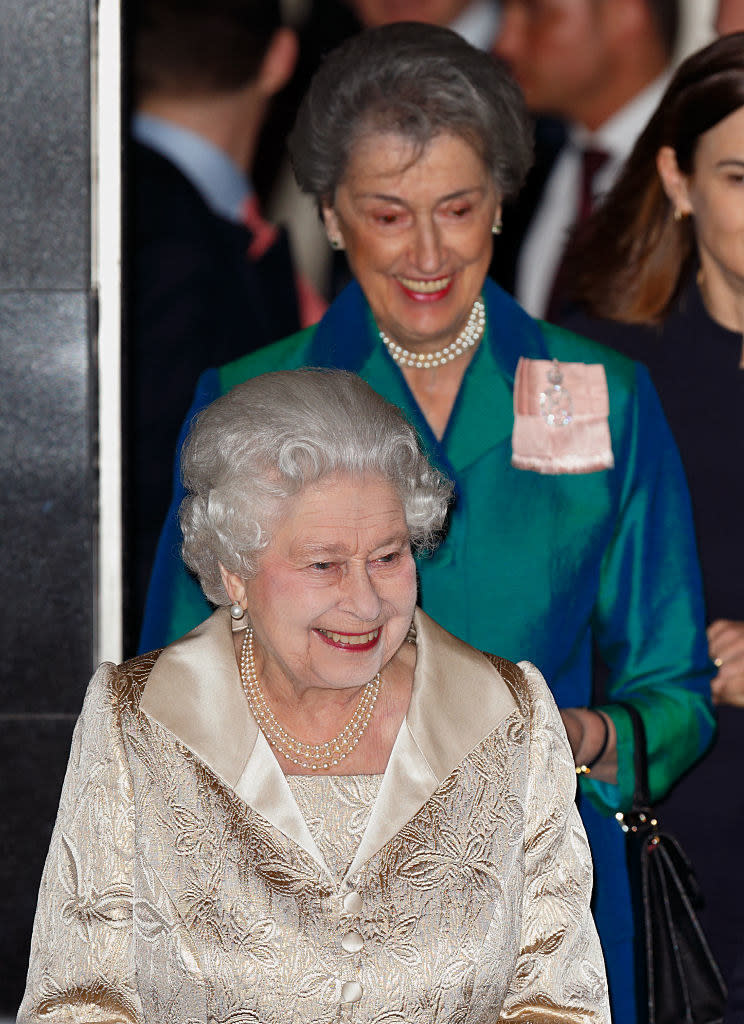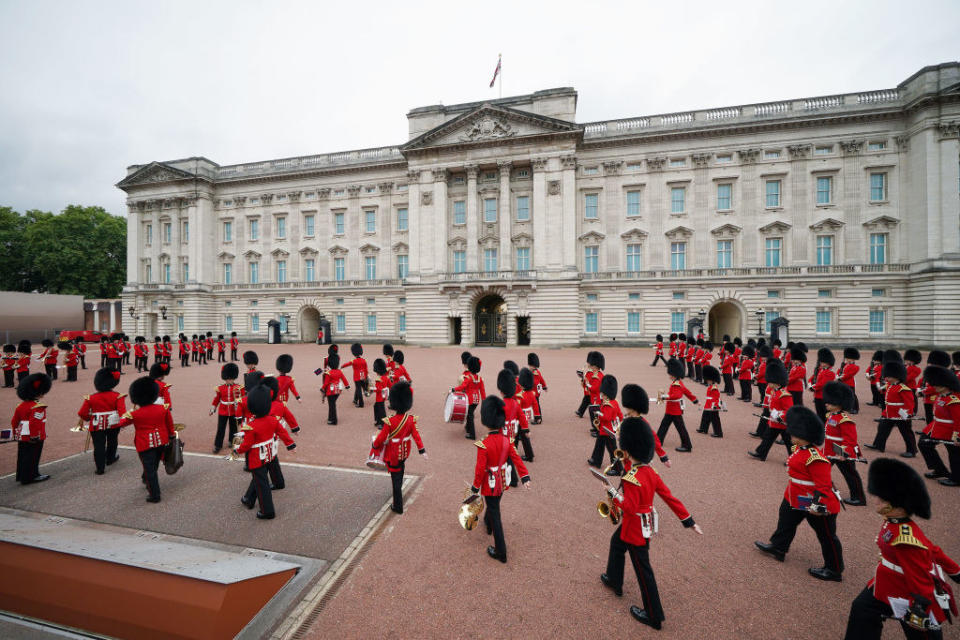I Have Some Questions About How The British Royal Family, Uh, Works — So I Found The Answers
Following Queen Elizabeth II's recent death, there has been non-stop coverage of her long reign and legacy, her successor King Charles III, and what comes next for the monarchy, which is revered by some, politely ignored by others, and made the subject of many a "wait, why does this still exist" conversation by the remainder.

Through watching the news (and also The Crown), I've discovered that my understanding of the traditions and whims of the British royal family is somewhat...lacking. I'm an Australian citizen, so technically the Queen or King of Britain is my sovereign. Does this affect my life literally at all? No! Do I still want to know more about the nitty-gritty of this institution that inexplicably coexists in the same day and age as Twitter? Absolutely.
So I wrote down all the questions I kept asking my empty living room while watching the recent royal coverage and found some answers.
1.I don't know much, but I know that when you see a royal, you're supposed to bow or curtsy. But do members of the royal family bow and curtsy to each other?

The Queen's kids bow and curtsy to her in The Crown, which seems like a waste of time better spent hanging out with corgis, but hey, that's just me, as in, a person who doesn't know how to curtsy. I think you get in one of the ballet positions, then go weak at the knees for a few seconds? It's unclear.
The Answer: It seems like the answer is yes, but it's complicated. First of all, the official Royal Family website, royal.uk, notes that there are "no obligatory codes of behavior" you must observe when meeting a royal, but that the "traditional forms" of a bow from the neck (for men) and a curtsy (for women) remain common. Regrettably, there's no mention of the acceptability of a high-five or finger guns.
The official website doesn't mention the rules around the royals greeting each other, either. A historian named Marlene Eilers Koenig told Hello! in 2018 that those with the title "royal highness" only curtsy or bow "to the sovereign," aka the King or Queen, and not to the other members of the family with their same title and status. According to Koenig, the royal kids are expected to start bowing and curtsying around the age of 5.
And according to the New York Times, which published a detailed guide to curtsying in 2018, Princess Catherine is required to curtsy to "royal princesses by blood," since she is a royal princess by marriage. However, if her husband Prince William is with her, those blood princesses (super metal band name, by the way) have to curtsy to her.
That's not too much to remember, right?
2.On the off chance that a Windsor invites me to tea, what should I call them?

Your highness? Your royal highness? Your Majesty? Harry?
The Answer: According to an explainer on royal.uk, had I met the Queen, I should've first called her "Your Majesty," followed by "Ma'am," which they point out rhymes with "jam." Both male and female members of the royal family should be addressed as "Your Royal Highness," followed by "Sir" and "Ma'am," respectively.
The "Ma'am rhymes with jam" rule is tricky, because it's so catchy, and there must be at least one person out there who got nervous and told a princess, "Thank you, Jam. Ma'am! Rhymes with jam. Oh, no."
3.How often do they break out the really shiny stuff?

You know that question that floats around the internet on a regular basis, the one that goes something like, "What incorrect thing did you wholeheartedly believe as a child?" One of mine was that the Queen wore her crown all the time, so that everyone would know that she was the Queen. Being that she was one of the most famous women in the world, this turned out not to be the case, but still, what separates a crown moment from a...not-crown moment?
The Answer: According to the Historic Royal Palaces website, the crown with which Queen Elizabeth was literally crowned, the St. Edwards Crown, is only worn for a sovereign's coronation, so the last time it was used was 1953. It weighs around 5 pounds. The Imperial State Crown is what the Queen wore while leaving Westminster Abbey following her coronation, and also while conducting important symbolic duties, like the "annual State opening of Parliament." According to the BBC, this was the crown resting on the Queen's coffin during her funeral. It weighs a little under 2.5 pounds, and in 2018, the Queen joked that she couldn't bend her head to read a speech while reading it, because it was so heavy that one's "neck would break" if they tried.
4.Are ladies-in-waiting still a thing?

Ladies-in-waiting exist in the same mental space for me as jesters. Wait, are jesters still a thing?
The Answer: Indeed they are! (Ladies-in-waiting, that is.) Lady Susan Hussey, pictured with Her Majesty in 2016, was the Queen's longest-serving lady-in-waiting; according to the Independent, she was with the Queen for over 60 years, having been appointed after Prince Andrew was born to help Her Majesty keep up with correspondence. She's so close with the family that she was even named Prince William's godmother.
According to an explainer of the gig published by Slate in 2011, ladies-in-waiting aren't paid and don't necessarily have to be of aristocratic origin. Apparently, their duties range somewhere in between "personal assistant" and "confidant/bestie."
Jesters, meanwhile, have gone out of style. Long live jesters.
5.Exactly how much money do these people have, anyway?

Look, we're all thinking it.
The Answer: Short answer: A lot.
Long answer: In 2021, Forbes reported that the royal family possesses a fortune of $28 billion, much of which derives from valuable real estate holdings such as Buckingham Palace, which the outlet estimated has a price tag of around $4.9 billion. However, the Windsors are not free to sell this real estate as they please, since it belongs to the institution of the monarchy. They do receive a quarter of the profits from the Crown Estate, which Forbes estimated is worth $19.5 billion; this is known as the "Sovereign Grant," with the remaining profits going to the British government. According to the United Kingdom's government website, the Sovereign Grant is meant to fund the Queen or King's duties as a Head of State, including paying staff, traveling, and hosting events such as "garden parties." According to the Guardian, unlike other citizens of Great Britain, King Charles isn't obligated to pay the 40% inheritance tax necessitated by law when an inheritance exceeds £325,000, or around $365,109 USD.
As for Her Majesty herself, Forbes estimated that Queen Elizabeth II possessed around a half billion, split between personal assets like art, her jewelry, and not one but two castles in Sandringham House and Balmoral. She wasn't required to pay income tax, but the Guardian reported that she started doing so voluntarily in the early 1990s.
6.How royal do you have to be to marry a royal?

Clearly the whole "you have to marry other members of royalty" thing has gone out of style, in light of the whole "genetics" thing. But are heirs to the throne and other senior royals still expected to marry people who are...I don't know, highborn? Actually, I think that might be a Game of Thrones term.
The Answer: According to a Vogue article published in 2018, the royals are in fact permitted to marry "commoners," which is a word we still use, apparently. But you have to get the Queen's — and now, the King's — permission to do so.
7.Do royal kids go to school and, later, university? Or are they taught by private tutors? Has a single one of them ever failed a test?

"I swear to god, Your Royal Highness, if I catch you texting in class again, I'll...I'll...I'll politely but firmly request that you return to your studies after completing your correspondence."
The Answer: Let's start with Queen Elizabeth II and work our way forward. According to royal.uk, Her Majesty and her younger sister, Princess Margaret, were taught at home. When Princess Elizabeth became next in line to the throne following her uncle's abdication, she began to receive lessons in constitutional history and law from the Vice-Provost of Eton College, an extremely fancy school we'll circle back to momentarily, as well as religious instruction from the Archbishop of Canterbury, which would sort of be like me, back in my Catholic school days, getting quizzed by the Pope.
As for King Charles, the official website of the Prince of Wales (Charles's position prior to the death of his mother) reports that the young Charles attended school in London for 10 months before becoming a boarding student at Cheam School in Berkshire. In 1962, he enrolled in Gordonstoun, a Scottish school of which his father, Prince Philip, was an alum. During his time in high school, he studied as an exchange student in Melbourne, Australia. Charles ultimately studied history at Cambridge University after pivoting from archaeology and anthropology; he also spent a term learning Welsh at the University College of Wales at Aberystwyth, because, you know, Prince of Wales.
According to the Independent, Prince William and Prince Harry both attended the aforementioned factory o' poshness known as Eton. The Los Angeles Times reported that Prince William went on to study geography at the University of St. Andrews, while Prince Harry decided to go from Eton into military training at the Royal Military Academy Sandhurst.
No word on whether any of them ever failed a test.
8.People seemed to really like Queen Elizabeth II, even people who would otherwise be opposed to a monarchy. But how do the people feel about King Charles III?

Everything I know about Charles I know from The Crown, and based on the last season alone, his public reputation seems to be...fraught. And individual sovereign aside, the idea of having any kind of sovereign has lost significant steam in the modern era. (See above: multiple crowns, no taxes.)
The Answer: According to the data analytics firm YouGov's latest survey on King Charles III, which was conducted in Quarter 2 of 2022, he was liked by 42% of respondents and disliked by 24%, leaving 30% who feel neutrally about the brand-new king. In contrast, Queen Elizabeth II enjoyed a popularity rating of 75%, with 8% of people expressing dislike and the remaining 14% going, "Eh."
9.And finally: What's with all the corgis?

One of the most instantly recognizable symbols of Queen Elizabeth's reign was her beloved platoon of corgis, aka Great Britain's true nobility. But how did these sentient loaves of bread rise about their station to become stalwart companions to Her Majesty?
The Answer: She just liked 'em!
Princess Elizabeth grew up with corgis, and was gifted one named Susan for her 18th birthday. According to the BBC, the Queen would go on to own "more than 30 of Susan's descendants," whom she referred to as "the boys" and "the girls." This fuzzy family line resulted in the creation of the corgi-dachshund crossbreed, known as the dorgi, when a corgi named Tiny had a romantic encounter with Princess Margaret's dachshund back in the '70s. The Queen actually stopped breeding corgis in recent years, reportedly because she didn't want to leave behind any puppies when she died.
And I didn't use it as a source, but I wholeheartedly recommend the "Royal corgis" Wikipedia page, which is a hell of a read and contains a whole section for "Attacks." It seems that despite being raised in the lap of luxury, some of these Susan Jr.'s were super crotchety.